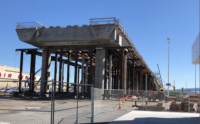Airports Need Greater Flexibility Than Ever in COVID-19 Era

Construction continues at Atlanta airport during pandemic. Photo courtesy of ATLNext
The airport development sector is preparing for the eventual return of international and business travel by taking another look at deployment and delivery of capital programs, speeding up technology implementation and finding ways to reassure the flying public. Big questions include the timeframe for recaptured passenger growth and whether a recovery stimulus package will take off anytime soon.
Airports will for the most part continue with their capital programs, but “there will be many changes in the character of the projects,” said Angela Gittens, former director general of Airports Council International World. She told attendees of the group's annual meeting Nov. 10 that “there will be more interest in items that may have been off the table before, like partial privatizations or creative ways of getting revenue in the short term.”
Ginger Evans, chief strategy officer for CAG Holdings, cautioned that the recovery, whatever its timeframe, will be “spiky and bumpy.” Airports next year will need to to consider short-term adjustments to rates and charges on terminal lease agreements to keep from driving traffic away, she said.
John Selden, general manager of Hartsfield-Jackson Atlanta International Airport, said its capital plan is 100% underway. The world’s busiest passenger airport with 114 million annual passengers before the pandemic, the facility has a $7.5-billion 2030 master plan. “We believe will eventually get back to that [114 million] number," Selden said. “This is a great time to build, with less traffic and less flights.”
But medium and smaller airports will have a harder time dealing with the financial impact of the pandemic than large and hub airports, said Gittens. Airports owned by municipalities must anticipate that those owners will have limited financial capacity to help them, she noted.
Panelists concurred that the current airport-airline-concessions model needs to be updated, particularly minimal annual guarantees regarding the rent paid to airports by tenants of the terminal.
“The concessions model, with minimal annual guarantees and rents and low percentages of gross revenues, is way outdated. Minimal annual guarantees should be minimal at best," Selden said. "Will airports take over some concessions and manage revenues through different franchise and contract agreements?”
Airports should plan for the possibility of privatizing non-core assets such as the IT system and cargo buildings, added Evans. “Maybe that willl never be needed, but 2021 is going to be a very tough year.”
Selden noted that airports in the future will have smaller headhouses, as the need for ticketing lobby space will decrease. “Someday I will get out of my transport, and my face is my ticket all the way to the gate.”
The Atlanta airport was able to close three concourses and consolidate passenger traffic into the others, allowing some concessionaires to still make some money and decreasing janitorial and electricity costs. “The terminal has to be able to be collapsed to meet [varying levels of] demand,” he said. “If you build enormous structures that you cannot segregate, you’ll have a problem.”
Panelists agreed that business and international travel will increase next year.
Evans said leisure travel within the U.S. had been growing until October at a rate of about 2% a week—then dropped again as the next pandemic wave hit. “This will continue for a while,” she warned. “For a facility as complex as an airport, the only way to handle it is with automation and technology.”
Selden urged airport consultants to look at the age of facilities. “There’s so much repair and renewal work that needs to be done. Let’s get away from ‘let’s design this magnificent terminal’ to maintaining existing infrastructure, and upgrading it to be more resilient.”
Along those lines, Evans urged airports to learn from other business sectors. She cited a workshop on HVAC system technologies she had attended: “I thought the most relevant expertise would come from health care,” she said. “But the best expertise came from an MGM [hotel] facilities manager.”



